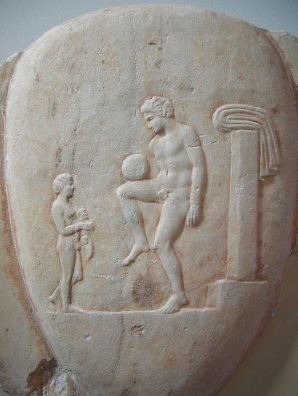When Was Modern Soccer Invented?

Soccer is one of the most loved games of this era, and its fame is wide-spread, regardless of the geographical status. The game has been evolving and surviving through eras and ages. It has been reported that soccer is as old as early human civilization. However, different schools of thoughts are still confused about the inventors of modern-day soccer. So, we are here with all the important information from the past to help you learn about the transformation of soccer from ancient to modern times.
Early History of Soccer
It is believed that England invented modern soccer in the 1860s when rugby was separated from it. However, some early forms of this game were also recorded in China around the second century B.C. during the Han Dynasty, and there are several other examples of its existence in the ancient times. Let’s have a look at the olden-days soccer and how is it different from the modern game.
1. Chinese Soccer
As highlighted earlier, one of the oldest forms of soccer was seen around 255-206 B.C. during the Han Dynasty in China. The sport was named as Tsu Chu, which is a Chinese term meaning kicking the ball.
According to the game rules;
- Players had to stuff a leather ball either with features or hair to give it some volume and bounce.
- The use of hands was prohibited, and players would have to control the ball with their feet.
- Players were allowed to use their body parts to hit the ball, including shoulders, chest and back.
- Regardless, there were no standard sets of rules for the game.
- The ball used in Tsu Chu was around 35 cm wide.
- A net was also included in the setup that was made of bamboo canes.
- The net was one of the most visible differences between Tsu Chu and modern soccer. It used to be elevated almost 30 feet away from the ground.
2. Ancient Greek Soccer

Another story of ancient soccer version was reported in Greece around 2500 B.C., titled as the Greek Episkyros. In this game, players had to move the ball towards the boundary mark of the opposite team with speed and perseverance.
Another similar game was played around 3,200 B.C. in ancient Mesoamerica, where ball was symbolized with the sun. Moreover, the captain of the losing team was sacrificed to gods as a punishment.
3. The English and European Soccer
Preserved through medieval period; soccer arrived in England in the 9th century.
- People there used to play a form of soccer called folk football where a pig bladder was utilized to kick around the street.
- However, some old Britain areas prohibited this game and considered it nuisance instead of entertainment.
- Still several people were playing it on the Britain roads.
- There wasn’t a proper setup nor the boundaries were defined.
- Players would wear their normal clothes instead of uniforms, so there was no way to distinguish between teams and players.
- At this time, soccer was basically a mix of rugby and soccer procedures in which players were allowed to grapple and handle the ball.
- The size of ball was not defined, neither a fixed duration of the game was decided nor the limit for number of players was standardized.
- Through the 1800s, the evolution of soccer was led by two schools: Rugby and Elton.
The Combination of Rugby and Soccer
| The Rules of Elton | Rugby Rules |
| Players could move the ball with feet only. | The use of hands was also allowed in Rugby. |
| It was referred to as the dribbling game’. | Rugby was also named the running game. |
| The rules were pretty close to the modern-day soccer. | The game was different from what we play today in soccer. |
This mix of two games continued until 1848 when a revolutionary meeting was held in Cambridge to standardize the laws of the game.
Cambridge Rules – 1848
In the beginning of 19th century; public and private school introduced a game to the students, which was pretty much like football. It featured a field and two goals where the player had to kick the ball into the goal. However, a few schools would allow holding the ball (similar to rugby), while some would permit kicking and dribbling of the ball, like modern soccer.
Due to growing popularity of this game across the country; teams started playing against other schools. However, the rules of each school were different from the other, so it was difficult to compete like that. At that time, there was a high need of standardizing the play. For this purpose, teachers from several schools called for a meeting at the Cambridge University to develop a drafted set of rulings. Here are the highlights of this meeting:
- Some rules from the new soccer were excluded, like running with the ball, use of hands, awarding goals.
- Players were instructed to wear same hat as other team members to differentiate easily during the game.
- Shin-kicking was not allowed else the team would be facing a penalty.
These rules were referred to as Cambridge Rules, and they were practiced by several teams throughout the country.
Soccer Clubs
Since 15th century, soccer was famous in England. However, it lacked the formality and organization that is found in today’s soccer. Although small teams and communities existed at that time, but no official status was given to them. Hence, official clubs couldn’t be found.
Back in 1824, formal soccer clubs were established in Edinburgh when the game was played between the teams of different schools. Notts County is the oldest soccer club in the history that was made in 1862 in Nottingham, England.
In the middle of the 18th century in Europe, the industrial revolution took place in England, which played an important part in the improvement of soccer logistics. Bigger stadiums with better grounds were built, and the publicity game of soccer was also strong.
Later in 1863, several clubs were established in England to play against each other. The team used to add ‘F.C.’ in the end of their names, meaning Football Club. It was actually a simple way of revealing that your club belongs to a certain school or town. For instance, Liverpool F.C. meant Football Club from Liverpool. When more clubs joined in; a governing body to manage them was a requirement.
Finally, on 26 October 1863, the first ever Football Association was established, and Rugby parted its ways due to some clash in the opinions.
Transition of Rugby to Soccer
The Football Association imposed a restriction on carrying the ball or use of hands in any way while playing. Moreover, shin-kicking and tripping were also prohibited. The organization decided the size and weight of the ball as well to ensure uniformity in the play.
However, a club named Blackheath was not happy with these rules. They wanted to retain the physicality that was the main of rugby. As a result, they chose to get separated from the federation and continue with the old set of rules. That is how, rugby formally moved apart from soccer, and this was the point when foundation of modern soccer was laid.
The Growth Of Modern Soccer
In the late 1800s, as the association football raised in fame, the resident countries started adapting the rules of the game, including Switzerland, Chile, Denmark, Finland, Ireland, Argentina, Scotland, the Netherlands, Germany and more.
Have a look at the highlights of previous matches over the past tournaments to witness a prominent raise in the number of viewers overtime.
- Soccer became an international phenomenon by 1872, with a good number of viewers enjoying an epic match between Scotland and England at the Hamilton Crescent. There are around 4,000 spectators watching the match. However, it was a draw at the end.
- In 1892, the final of F.A. Cup was played between Notts County and Bolton Wanderers and over 37,000 viewers were present in the audience. The game was won by Notts County by 4-1.
- In 1883, the first international competition was held which was attended by four nations, including Wales, England, Ireland and Scotland.
- By 1867, soccer was not just restricted to Europe, but it was spread within Asia and South America as well.
- By the 1900s, the game was becoming a favorite of the massive number of audiences across the globe, and it was flourishing in Argentina already.
The Formation of FIFA
On 21st May 1904, FIFA (The Federation Internationale de Football Association) was formed in which signatories from different countries came together, including France, Sweden, Switzerland, Denmark, Spain, the Netherlands and Belgium. The establishment of this federation encouraged the growth of modern soccer that we play today.
- The first FIFA World Cup was played in 1930.
- Although Britain was inducted into FIFA by 1905; however, they managed to represent in the World Cup till 1950.
- By 1908, soccer was considered as one of the official sports of the Olympic Games.
- At this point, massive investments were poured in the game with global admiration and growth.
- In 1950 World Cup, 200,000 spectators witnessed the final match.
Who Was The Inventor of Soccer?
Consider the Football Association as the foundation of modern soccer; Ebenezer Cobby Morley was one of the important men behind the venture. He established Barnes Football Club in 1862 and served as a captain for several years. The club was also a part of the first-ever soccer match that was held in 1863 with Richmond F.C.
Ebenezer was also involved in crafting the Laws of the Game in 1863, which are the rules used by the modern soccer of today. He was one of the pioneers responsible for encouraging play with feet and removing rugby style of the game.
Soccer in Recent Times
Nowadays, soccer is being played all over the world; from professional matches to youth leagues. However, the rules are standardized now with eleven players per team and prohibition of hand usage.
The passion of soccer is mind-blowing in the recent times. In fact, every one out of two people will be a soccer fan these days. The last World Cup in Russia reported over 3.5 billion viewers, which is a massive number.
The adoption of female soccer is not behind in any way either. Around 16 million viewers watched the match between the Netherlands and US soccer team in the FIFA Women’s World Cup final of 2019.
Conclusion
Several countries played their part in the formation of modern soccer (association football) that we all love today. Back in 1848 and 1863, the game was modernized by England with the introduction of rules and uniforms. Gradually, soccer became popular in different schools, towns and other countries as well. That is when FIFA was established to bring uniformity in the play.
So, next time if you are questioned about the inventor of soccer, then don’t hesitate to answer that many countries played an important part in shaping the venture, making it a global phenomenon. Regardless, England still gets the biggest share as its contributions were more than the rest.




